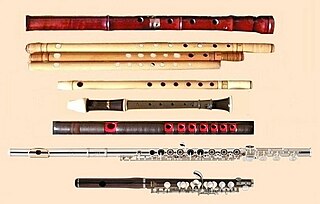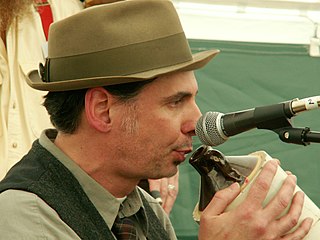
Accordions are a family of box-shaped musical instruments of the bellows-driven free reed aerophone type. The essential characteristic of the accordion is to combine in one instrument a melody section, also called the diskant, usually on the right-hand keyboard, with an accompaniment or Basso continuo functionality on the left-hand. The musician normally plays the melody on buttons or keys on the right-hand side, and the accompaniment on bass or pre-set chord buttons on the left-hand side. A person who plays the accordion is called an accordionist.
The clarinet is a single-reed musical instrument in the woodwind family, with a nearly cylindrical bore and a flared bell.

The flute is a member of a family of musical instruments in the woodwind group. Like all woodwinds, flutes are aerophones, producing sound with a vibrating column of air. Flutes produce sound when the player's air flows across an opening. In the Hornbostel–Sachs classification system, flutes are edge-blown aerophones. A musician who plays the flute is called a flautist or flutist.

A percussion instrument is a musical instrument that is sounded by being struck or scraped by a beater including attached or enclosed beaters or rattles struck, scraped or rubbed by hand or struck against another similar instrument. Excluding zoomusicological instruments and the human voice, the percussion family is believed to include the oldest musical instruments. In spite of being a very common term to designate instruments, and to relate them to their players, the percussionists, percussion is not a systematic classificatory category of instruments, as described by the scientific field of organology. It is shown below that percussion instruments may belong to the organological classes of idiophone, membranophone, aerophone and chordophone.

In organology, the study of musical instruments, many methods of classifying instruments exist. Most methods are specific to a particular cultural group and were developed to serve that culture's musical needs. Culture-based classification methods sometimes break down when applied outside that culture. For example, a classification based on instrument use may fail when applied to another culture that uses the same instrument differently.
A music sequencer is a device or application software that can record, edit, or play back music, by handling note and performance information in several forms, typically CV/Gate, MIDI, or Open Sound Control, and possibly audio and automation data for digital audio workstations (DAWs) and plug-ins.

An aerophone is a musical instrument that produces sound primarily by causing a body of air to vibrate, without the use of strings or membranes, and without the vibration of the instrument itself adding considerably to the sound.

A player piano is a self-playing piano with a pneumatic or electromechanical mechanism that operates the piano action using perforated paper or metallic rolls. Modern versions use MIDI. The player piano gained popularity as mass-produced home pianos increased in the late 19th and early 20th centuries. Sales peaked in 1924 and subsequently declined with improvements in electrical phonograph recordings in the mid-1920s. The advent of electrical amplification in home music reproduction, brought by radios, contributed to a decline in popularity, and the stock market crash of 1929 virtually wiped out production.

A bansuri is an ancient side-blown bamboo flute originating from Indian Subcontinent. It is an aerophone produced from bamboo and metal like material used in many Indian and Nepali Lok songs. A bansuri is traditionally made from a single hollow shaft of bamboo with seven finger holes. Some modern designs come in ivory, fiberglass and various metals. The six hole instrument covers two and a half octaves of music. The bansuri is typically between 30 and 75 centimetres in length, and the thickness of a human thumb. One end is closed, and few centimeters from the closed end is its blow hole. Longer bansuris feature deeper tones and lower pitches. The traditional design features no mechanical keys, and the musician creates the notes they want by covering and uncovering the various finger holes.

The kaval is a chromatic end-blown oblique flute traditionally played throughout the Balkans and Anatolia. The kaval is primarily associated with mountain shepherds.

The pungi, also known as bīn or Murli, is a musical instrument that originates from the Indian subcontinent. The instrument consists of a reservoir into which air is blown and then channelled into two reed pipes. It is played with no pauses, as the player employs circular breathing. In street performances, the pungi is used for snake charming.
The venu is one of the ancient transverse flutes of Indian classical music. It is an aerophone typically made from bamboo, that is a side blown wind instrument. It continues to be in use in the South Indian Carnatic music tradition. It is referred to as nadi and tunava in the Rigveda and other Vedic texts of Hinduism. In northern Indian music, a similar flute is called bansuri. In the south, it is also called by various other names such as pullanguḻal (புல்லாங்குழல்) in Tamil, oodakuḻal (ഓടകുഴൽ) or kurungu kuḻal in Malayalam (Kerala) and ಕೊಳಲು (koḷalu) or ಮುರಳಿ (muraļi) in Kannada (Karnataka). It is known as pillana grōvi or vēṇuvu (వేణువు) in Telugu. It is also called as Carnatic Flute.

A one-man band is a musician who plays a number of instruments simultaneously using their hands, feet, limbs, and various mechanical or electronic contraptions. One-man bands also often sing while they perform.

The jug used as a musical instrument is an empty jug played with buzzed lips to produce a trombone-like tone. The characteristic sound of the jug is low and hoarse, below the higher pitch of the fiddle, harmonica, and the other instruments in the band.

A single-reed instrument is a woodwind instrument that uses only one reed to produce sound. The very earliest single-reed instruments were documented in ancient Egypt, as well as the Middle East, Greece, and the Roman Empire. The earliest types of single-reed instruments used idioglottal reeds, where the vibrating reed is a tongue cut and shaped on the tube of cane. Much later, single-reed instruments started using heteroglottal reeds, where a reed is cut and separated from the tube of cane and attached to a mouthpiece of some sort. By contrast, in a double reed instrument, there is no mouthpiece; the two parts of the reed vibrate against one another. Reeds are traditionally made of cane and produce sound when air is blown across or through them. The type of instruments that use a single reed are clarinets and saxophone. The timbre of a single and double reed instrument is related to the harmonic series caused by the shape of the corpus. E.g. the clarinet is only including the odd harmonics due to air column modes canceling out the even harmonics. This may be compared to the timbre of a square wave.

The use of electronic music technology in rock music coincided with the practical availability of electronic musical instruments and the genre's emergence as a distinct style. Rock music has been highly dependent on technological developments, particularly the invention and refinement of the synthesizer, the development of the MIDI digital format and computer technology.
In the context of musical performance, air instruments refers to the miming of sound-producing-gestures used in playing musical instruments. Simply put, air instruments are imaginary. Examples of air instruments include but are not limited to:

A musical instrument is a device created or adapted to make musical sounds. In principle, any object that produces sound can be considered a musical instrument—it is through purpose that the object becomes a musical instrument. A person who plays a musical instrument is known as an instrumentalist.

A vessel flute is a type of flute with a body which acts as a Helmholtz resonator. The body is vessel-shaped, not tube- or cone-shaped; that is, the far end is closed.














